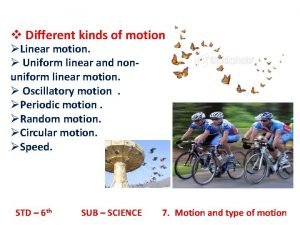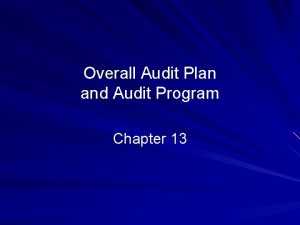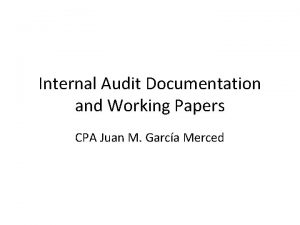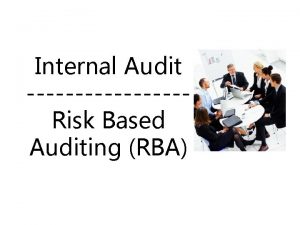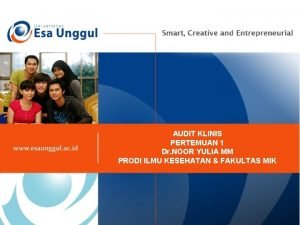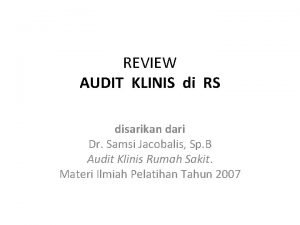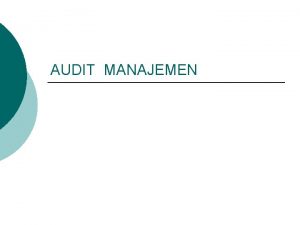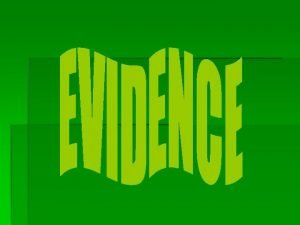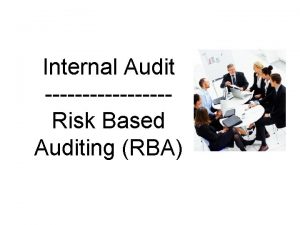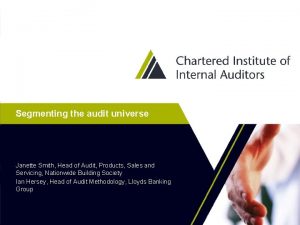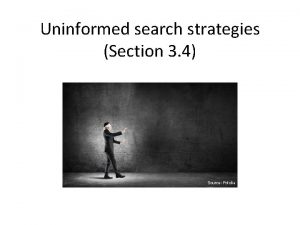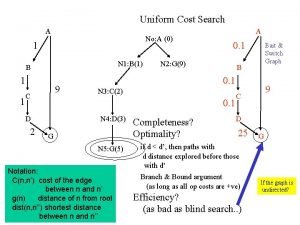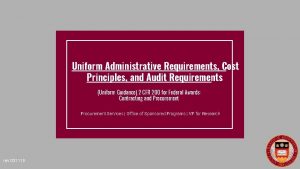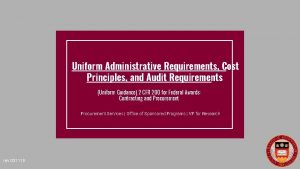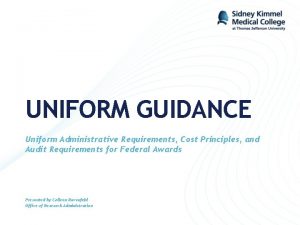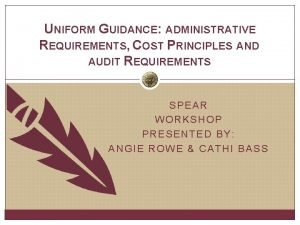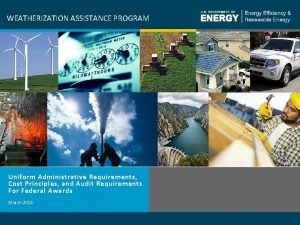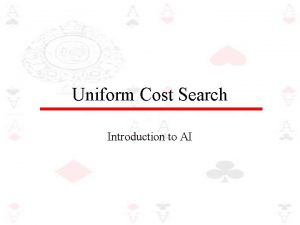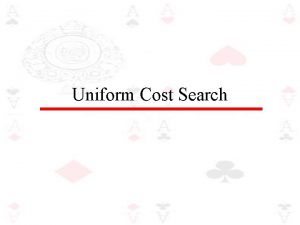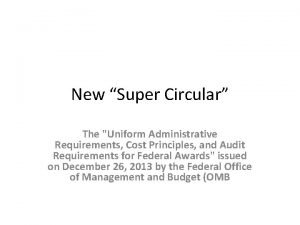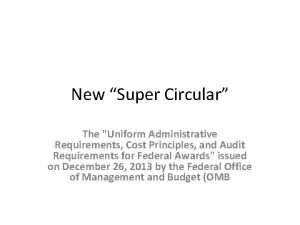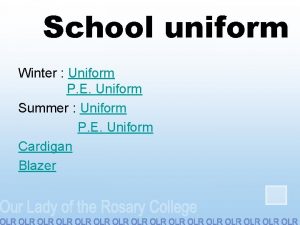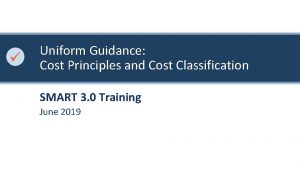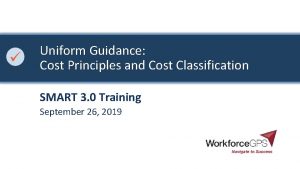The Uniform Administrative Requirements Cost Principles and Audit


















- Slides: 18

The Uniform Administrative Requirements, Cost Principles, and Audit Requirements for Federal Awards The OMB Super. Circular Information for FTA Grantees July 30, 2015 TPM – 32 Guidance Division

What is the Super. Circular? The Super Circular standardizes: ü Definitions; ü General provisions; and ü Pre- and Post-award requirements across the OMB Circulars. The Super. Circular also: ü focuses on performance rather than compliance as a means for fiscal accountability; ü encourages the use of Information Technology and shared services, and ü strengthens oversight requirements. 2

What is the Super. Circular? On December 26, 2013, the Office of Management and Budget (OMB) published final guidance in the Federal Register entitled, "Uniform Administrative Requirements, Cost Principles, and Audit Requirements for Federal Awards" ("Final Guidance"), to be located at Title 2 of the Code of Federal Regulations ("C. F. R. "). • All Federal and non-Federal entities expending Federal funds, including direct recipients, subrecipients or pass-through entities, are affected by these changes. (200. 101) • Agencies were given a year to review, accept and request deviations from the established policies. • DOT incorporated the Super. Circluar into its regulations on December 19, 2014 under 2 CFR Parts 1200 and 1201. Title 49 CFR Parts 18 and 19 (the Common Rules) are removed under Part 1201. 3

What is the Super. Circular? This guidance supersedes the following OMB Circulars (200. 104): ü Awards to: • A-102 State and Local Governments • A-110 Higher Education, Hospitals, and Other Nonprofit Organizations ü Cost Principals for: • A-21 Educational Institutions • A-87 State, Local, and Tribal Governments • A-122 Non-Profit Organizations ü A-89 Federal Domestic Assistance Program Information ü A-133 Audits of States, Local Governments and Nonprofit Organizations 4

DOT Deviations The Department of Transportation (DOT) modes (including FTA) submitted the following deviations to the Super. Circular to OMB for approval: ü § 1201. 80 Program Income ü § 1201. 102 Exceptions ü § 1201. 106 DOT Component Implementation ü § 1201. 107 DOT Headquarters Responsibilities ü § 1201. 108 Inquiries ü § 1201. 109 Review Date ü § 1201. 112 Conflict of Interest ü § 1201. 206 Standard Application Requirements ü § 1201. 313 Equipment ü § 1201. 317 Procurements by States ü § 1201. 327 Financial Reporting All of the deviations DOT proposed were approved by OMB, with the exception of the § 1201. 319 Competition, which has been published in the Federal Register for negotiated rule making to allow for geographic hiring preferences for labor. 5

Pop Quiz 6

What’s in the Super. Circular? Reforms fall into three (3) main categories: (i) Administrative Requirements under Subparts A through D, covering OMB Circulars A-102, A-110 and A-89; Note: A-102 & A-110 = 49 CFR 18 & 19 (ii) Cost Principles under Subpart E, covering OMB Circulars A-21, A-87, A-122 and 45 C. F. R. Part 75 (iii) Audit Requirements under Subpart F, covering OMB Circulars A-133 and A-50 11 Appendices are also included in the Super. Circular 7

Overall Changes Highlighted Grant Terminology ü non-federal entity – refers to recipient, grantee, subrecipient, and subgrantee. FTA will continue to use recipient and subrecipient. ü Indian Tribe – federally recognized Indian tribe – identified annually on the published list of Indian Entities Recognized and Eligible to Receive Services. (200. 54) ü program income – gross income earned by the recipient or subrecipient that is directly generated by a supported activity or earned as a result of the grant or cooperative agreement during the period of performance. (1201. 80) ü period of performance – the time during which the non-Federal entity may incur new costs to carry out the work authorized under the award; Awarding agencies must include start and end dates of the period of performance in the Federal award (200. 77, 200. 210, 200. 331). 8

Quick Polls 9

Administrative Changes – SAM. gov • SAM streamlines 8 federal acquisition systems, including CCR and EPLS, is required at the time of application, and is used to initially evaluate grantee risk. • FTA may not make an award until recipient has complied with the requirement to provide a valid unique entity identifier and maintain an active SAM registration. • The unique entity identifier is the recipient’s DUNS number. 10

Administrative Changes Risk (200. 205 & 200. 331) – Awarding agencies are required to evaluate the merits and risks associated with an application & monitor awards to mitigate potential risks regarding compliance & performance requirements as well as waste, fraud & abuse. Targeting risks should allow grantees to meet performance milestones while working with awarding agencies to ensure compliance & attempt to mitigate identified risks. Conflict of Interest (200. 112 & 1201. 112) – These sections require recipients to disclose in writing to FTA or the appropriate pass through entity any potential conflict of interest. 11

https: //www. youtube. com/watch? v=7 wm-p. Zp_mi 0 12

Changes in Cost Principles ü Pre-award costs are allowable if required for the efficiency of the project and approved in writing. (200. 209 & 200. 458) ü Indirect Costs (200. 414) ü A de minimis indirect cost rate of 10% of modified total direct costs (MTDC) is now allowable for non-federal entities that have never had a negotiated indirect cost rate. ü Federal agencies are required to accept negotiated indirect cost rates unless there is an exception. ü Allow a one-time extension without further negotiation of a federally approved negotiated indirect cost rate for a period of up to 4 years. 13

Changes in Audit Requirements ü Single audit threshold is raised from $500, 000 to $750, 000. (200. 501) ü Federal awarding agencies are required to review audits submitted to the FAC before performing any additional audits. (200. 503) Non-federal entities are required to review audits for subawards (200. 331). ü An increase in the threshold for reporting questioned costs from $10, 000 to $25, 000. (200. 516) 14

Pop Quiz 15

The Super. Circular & You ü FTA’s 5010 Circular “Grant Management Requirements” is being revised to ensure consistency with MAP 21 as well as 2 CFR parts 200 & 1201. ü The Apportionment Notice is available for guidance and review right now. ü Master Agreement is being revised. 16

The Super. Circular & You The Apportionment Notice http: //www. gpo. gov/fdsys/pkg/FR-2015 -02 -09/pdf/2015 -02555. pdf • Any awards issued prior to December 26, 2014 remain active using the administrative and cost principle guidance when issued – OMB Circulars (A-87, A-133, etc. ) – DOT Common Rules (49 CFR Parts 18 & 19) • New awards or awards with new or additional funding issued after December 26, 2014 are impacted by the administrative requirements and cost principles of the new guidance – OMB’s Super. Circular is active (2 CFR Part 200) – Current FTA circulars should be followed until revised • New or renegotiated indirect cost rate agreements follow the requirements of the 200. 414 and the appropriate Appendix. • Audit Standards set forth in Subpart F (Audit Requirements) apply to audits of fiscal years beginning on or after December 26, 2014. 17

 How do you classify uniform and non-uniform mixtures?
How do you classify uniform and non-uniform mixtures? How do you classify uniform and non-uniform mixtures?
How do you classify uniform and non-uniform mixtures? Contoh soal aliran tidak seragam
Contoh soal aliran tidak seragam Which type of motion
Which type of motion Limitations of auditing
Limitations of auditing Overall audit plan and audit program
Overall audit plan and audit program Audit documentation working papers
Audit documentation working papers Perbedaan audit konvensional dengan audit berbasis risiko
Perbedaan audit konvensional dengan audit berbasis risiko Perbedaan audit medis dan audit klinis
Perbedaan audit medis dan audit klinis Beda audit medis dan audit klinis
Beda audit medis dan audit klinis Penyelesaian audit dan tanggung jawab pasca audit
Penyelesaian audit dan tanggung jawab pasca audit Perbedaan audit manajemen dan audit keuangan
Perbedaan audit manajemen dan audit keuangan Prosedur audit bottom-up dan audit top-down
Prosedur audit bottom-up dan audit top-down Perbedaan audit konvensional dengan audit berbasis risiko
Perbedaan audit konvensional dengan audit berbasis risiko The term audit originate from the latin word
The term audit originate from the latin word Audit universe adalah
Audit universe adalah Dfs
Dfs Uniform cost search
Uniform cost search Python yesterday
Python yesterday



